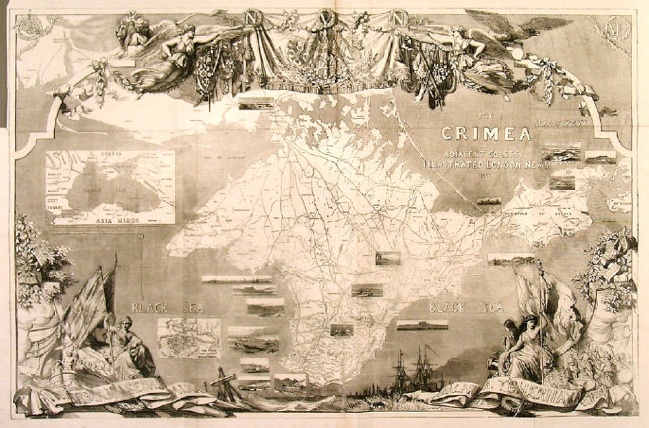2007

Since Ochakiv was only a side-trip, we didn't spend nearly as much time there as we would have liked to. Instead, we drove east, through Mykolaiv, crossing the Dnipro at Kherson1, and then heading south to the Autonomous Republic of Crimea2. It was not nearly as exciting as it sounds.

A mosque in northern Crimea
While Crimea is known for its beautiful scenery, said scenery seems to be mostly concentrated in the Southern half. Northern Crimea is flat, brown and agricultural –– the Crimean steppe. An occasional minaret3 and odd-sounding place names were the only clues that we'd crossed a cultural divide.
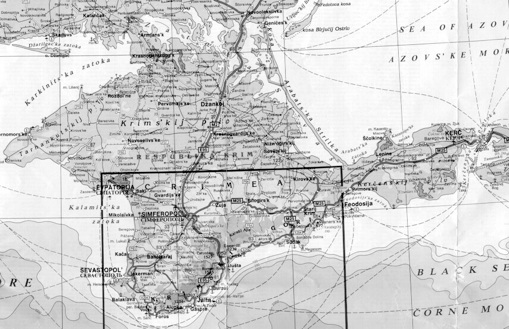
A road map showing the locations of Bilohorsk and Koktebel
Bilohirsk:
Traveling in Crimea takes much longer than one would expect. On a map, everything looks quite compact, the towns quite close to each other. But the roads are narrow and, as one heads south, the Crimean mountains warp the topography and twist the roads around. The drive becomes more interesting, but slow.
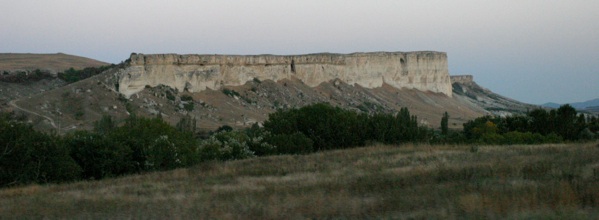
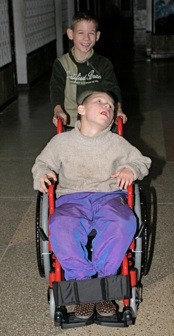
We had not planned a visit here, but had stopped to drop off some wheelchairs that Maryna had gotten as a donation for a European charity. There had been a bit of room left in the truck, and it was on our way...... Since we were there, we had a look around. Bilohirsk houses 125 children, each of whom has a mental disability, such as Down's Syndrome5. The children, who range in age from 4 to 18, were very, very sweet, and clung to us like old friends. We were charmed by them. In addition to the wheelchairs, we left toothbrushes, dental floss, chocolate and 15 meters of embroidery fabric. They were very grateful.
(Left: One of the children from Bilohorsk helps push his friend in the other child's new wheelchair.)
Köktöbel:
We drove through the night to get to the sea side town of Köktöbel, where we would be spending the next two nights. This old Tatar town has become quite the popular resort6, with beaches, a boardwalk7 lined with kiosks, shops and restaurants, attractions, wine "tasting halls8" and lots of lovely hotels. We had rooms at a a nice one, probably the nicest place I've ever stayed in Ukraine. It was a challenge to find at night, as there was no sign, but, with the aid of cell phones, we finally did. It had a large fountain with turtles out front, and (much too) nice furnishings9 throughout. The windows opened onto balconies that caught the sea breezes10.
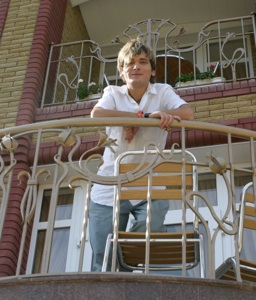
Main UKRAINE Page
Main ROUTE Page
___________
-
1.Kherson is the center of a huge agricultural area of Ukraine that produces vegetables for the entire country. The climate is warmer than further north, where wheat, potatoes, sugar beets and sunflowers predominate. There are markets along the highway, odd clusters of kiosks selling produce and dried fish. In one area, all of the kiosks were run by Koreans. At that time in September, there were huge bags of sweet peppers/capsicums and onions (especially the purple ones), and caviar in large jars.

Roadside market near Kherson -
2.Ukraine is a unitary state composed of 24 oblasts (provinces), one autonomous republic (Crimea), and two cities with special status: Kiev, its capital, and Sevastopol, which houses the Russian Black Sea Fleet under a leasingagreement. Crimea is not a historically ethnic Ukrainian region; it was settled at various time by Cimmerians, Greeks, Scythians, Khazars and, since the Middle ages, Tatars (left), a Turkic people.
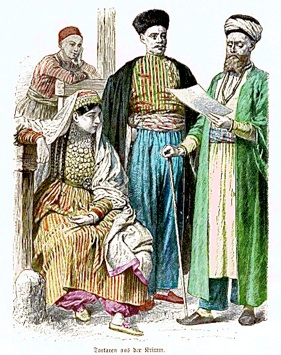
The Russians took control in 1783, and began a Russification process. Tatar culture was denigrated, and all of its palaces and grand buildings destroyed by Catherine, save one, in Bakhchysaray – because Pushkin wrote a poem about it. Many Tatars emigrated to Turkey, and Russians repopulated the land.
In 1944, Stalin deported the remaining Tatars, some 250,000, to Central Asia. About half of them died in transit and in exile. In 1954 Khrushchev transferred Crimea from Russia to Ukraine, his gift on the 300th anniversary of the Pereyaslav Treaty. -
3.The Tatars, like most Turkic peoples, are Muslim. Although Stalin did his best to get rid of them, the Tatars began returning to Crimea in the 1980s. SInce Ukrainian independence, many more have come, and they now number some 250,000. They have been slowly reclaiming their land (with difficulty) from the predominantly Russian population that moved here in the post-war period, when Crimea became the vacation destination of the Soviet Bloc.
In the summer of 2006 there were riots and a rebellion in Bakhchysaray, when the local government refused to keep its promise to take down a market that had grown up over a Tatar cemetery. The Tatars took matters into their own hands, pulling the structures down. There continues to be strife, as the Tatars try to reclaim that which was stolen from them. -
4.The Ukrainian name of the town means "white mountain", and was named after the mountain we had passed, a very prominent landmark. The original Crimean Tatar name Qarasuvbazar means "bazaar on the Karasu river".
-
5.When they age out of this internat, very few of these children return to their parents, although many have parents who visit. Although all of these children have less than average intelligence, many are trainable and none are invalids. The educational program here covers basic counting, coloring, painting, embroidering and for those who are able, reading. They also focus on self care.
-
6.It is quite popular, especially during the annual Jazz (and World Music) festival. We had hoped to stay inKöktöbel again on our return from Kerch, but couldn't get a room because of the festival. Instead we stayed in Feodosia, but came to Köktöbel for the evening. We got to listen to Maryna's son Orchyk perform with his band, Yogurt, probably the only Celtic band in Ukraine. They put on a very good show, and the lead singer looked quite smashing in a kilt.

Other acts included modern jazz (which left most listeners nonplussed) and a rap band.
-
7.It was a regular Ukrainian Coney Island. There were all sorts of games, including Dance Dance Revolution and a small group of carnival rides. Andriy made us come watch him ride one that threw him up in the air and spun him around. Apparently, on the previous night, on his first attempt, he screamed so much that it attracted an audience. We heard about his travails for days thereafter.

-
8.Crimea produces a lot of wine – it has a nice Mediterranean climate, hills, sunshine, and lot and lots of vineyards. Some of the wine is even quite good. There are now many "tasting halls" catering to the tourist trade. Sadly, despite two trips to Crimea, I've never had the chance to visit one and sample the wares – too much work and not enough time. We did have more than a few bottles of white Köktöbel wine with our meals, though – it has an initial bite, but then becomes a very pleasant wine.
-
9.The table and other furniture were too nice for a hotel, and we were afraid to use them – with good reason. Nellie managed to break off the handle to the door/window to their balcony. It must have been damaged already, because it's unlikely she's strong enough to rend solid metal like that. She injured herself in the process, albeit just a scratch. Still, when she reported it to management, they had a fit, blamed her, and insisted she pay for a new window. We had to argue, and finally agreed to half the cost. We won't be staying there again.
-
10.But no elevator or, in a remnant of Soviet-style service, bellhop. It is up to visitors to drag their luggage up the many flights of stairs by themselves. But one must do so very gently, or risk getting yelled at by the staff for marring their beautifully waxed stairs.

Coastline near Köktöbel
Crimea
